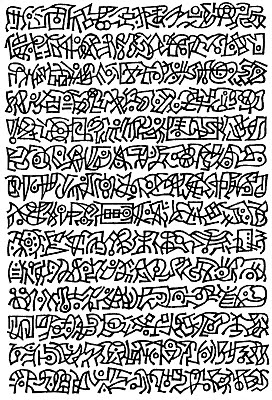
It is a style of writing with a long history. As you can see from the examples on Michael Jacobsen’s site, much of this work straddles the line between writing and modern art. The possibilities are fairly endless. Harvey Pekar has famously said, “Comics are words and pictures. You can do anything with words and pictures.” With asemic writing, the words become pictures and vice-versa, opening up new possibilities. Michael Jacobson says about the medium:
I consider my work to be a bead on a string with regards to the history of experimental literature, with asemic writing being the most recent bead added in a long string of avant-garde writing.
Writing, to me, is essentially coded marks on a surface, with asemic writing being an unspecified open semantic code—a code that is open to interpretation, with no fixed meaning. Breaking writing down to its most elemental form was probably first done by the Lettristes. But I see asemic writing as being a further erosion of text, down to axiom, texture, & line. If we were purely logical beings we would call it mathematics. I feel that now we are at the event horizon where language is being broken down to new forms of expression. Words, I think, don’t function as well in today’s post-literate culture as they have in the past. I believe asemic writing expresses some difficult emotions better than verbal writing. To me, there is more of a statement when somebody wears a symbol around there neck vs. the word for that symbol.
See a sample of The Giant’s Fence here:
It may seem nearly impossible to review such a book, as the interpretation is entirely subjective and there’s no “story,” but my criticism is pretty simple – the pages are a bit too uniform, one after the other with – more or less – the same basic layout as the page above. It makes it much harder to have a differing interpretation between pages. I’m reminded of this scene from “The Shining,” where Shelley Duvall comes upon the manuscript for “All Work and No Play Makes Jack a Dull Boy.” Each page is different – different paragraph styles, even dialogue, but with the same words. It makes it creepier and more meaningful than if he’d just written the same words over and over again in a block.
For a book of this type, that may seem like a false comparison – as paragraphs, quote marks, and other punctuation are all part of traditional writing. That’s entirely true, but then one of the tasks is to invent a new type of punctuation to at the very least open up the possibility for differing interpretation. One could argue that this is a book about subtlety – how the subtle differences in symbols can take on different meeting. And I’ll freely admit I’m an asemic writing newbie, but it’s harder to dig meaning out of cluttered blocks of symbols.
It’s possible that The Giant’s Fence is a more-challenging book of this type. Still, it manages to be impressively ambitious – page after page of new symbolic characters. And Jacobson is also an impressively ambitious spokesperson for the literary movement. Though this book didn’t move me particularly, the movement has so many possibilities that it’s worth exploring. Check out The New Post-literate: A Gallery Of Asemic Writing for many more examples.
Get an Editorial Review | Get Amazon Sales & Reviews | Get Edited | Get Beta Readers | Enter the SPR Book Awards | Other Marketing Services























Wow. Tackling a book such as this must be akin to deciphering one of the lost languages of Babel without the aid of a Rosetta Stone. I admire the creativity it took to produce the work, but am surprised that the review is so overwhelmingly positive, while works that are actually readable are so frequently nit-picked, which makes me wonder if there is an “intellectual” bias at work. I’m not saying that this book and its review are not valid. I’m just hoping that the “Self-Publishing Review” is not so self-absorbed that it favors experimental works over actual comprehensible writing.
That’s a weird comment, given that this is the only book of its kind that SPR has reviewed.
That’s my point, Henry. I am new to this site, but after perusing dozens of book reviews, I came to the conclusion that virtually none were worthy of recommendation by SPR. Then I find a review of an heiroglyphic, not-readable cryptogram, and it is overwhelmingly positive. I just, after reading dozens of reviews of actual, written in English books, was surprised that the most positive of reviews was given to this book. I very much enjoyed your review and especially liked the relation to “The Shining”. That was very cool that you uncovered that. I didn’t mean any offense. I guess I’m just wondering what SPR has deemed “good”. Maybe another tab is necessary on your homepage- ‘featured reviews’. I just want to see something positive, although I realize that self-publishing is more bad than good. Thanks for your feedback and I didn’t mean any offense.
And, upon a second reading, I see the review is not fawning. There is just criticism. Please consider that. I read a lot of reviews. Best wishes.